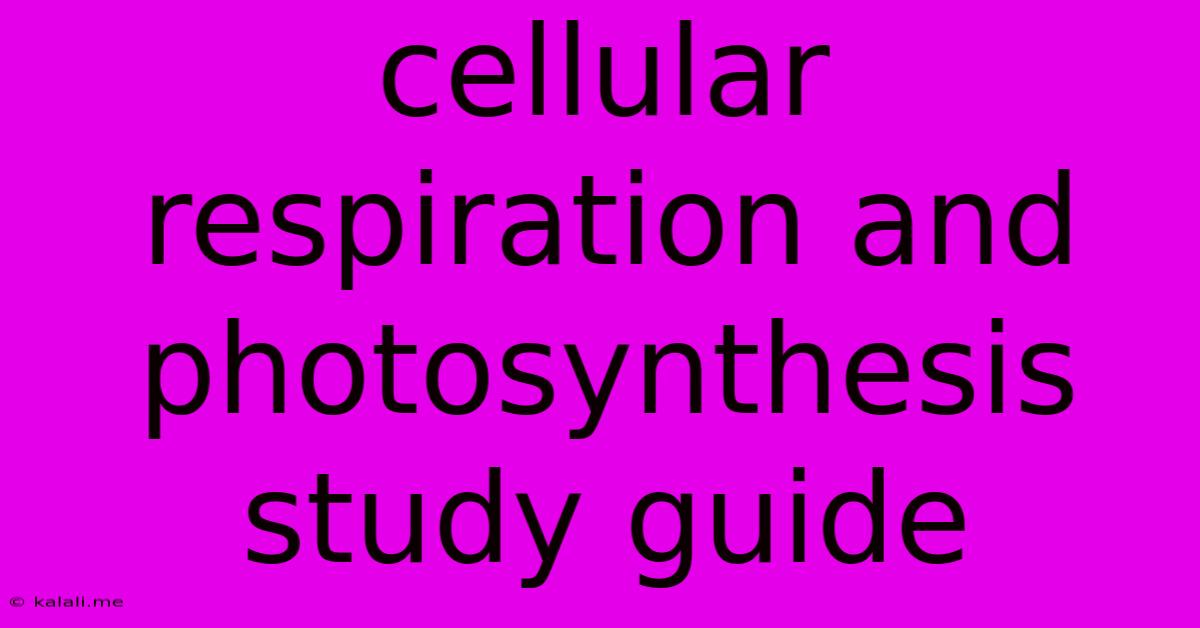Cellular Respiration And Photosynthesis Study Guide
Kalali
May 09, 2025 · 3 min read

Table of Contents
Cellular Respiration and Photosynthesis Study Guide: A Comprehensive Overview
This study guide provides a comprehensive overview of cellular respiration and photosynthesis, two fundamental processes in biology. Understanding these processes is crucial for comprehending energy flow within ecosystems and the interconnectedness of life on Earth. We will explore their similarities and differences, key steps involved, and the importance of each in maintaining life.
What is Cellular Respiration?
Cellular respiration is the process by which cells break down glucose (a simple sugar) to produce ATP (adenosine triphosphate), the primary energy currency of cells. This process occurs in the mitochondria, often referred to as the "powerhouses" of the cell. It's a catabolic process, meaning it breaks down complex molecules into simpler ones, releasing energy in the process. Think of it as the cell's way of "burning" fuel to generate usable energy.
Stages of Cellular Respiration:
- Glycolysis: This initial stage occurs in the cytoplasm and breaks down glucose into pyruvate, yielding a small amount of ATP and NADH (an electron carrier). It's an anaerobic process, meaning it doesn't require oxygen.
- Pyruvate Oxidation: Pyruvate is transported into the mitochondria and converted into acetyl-CoA, releasing carbon dioxide.
- Krebs Cycle (Citric Acid Cycle): Acetyl-CoA enters the Krebs cycle, a series of reactions that further break down the molecule, producing more ATP, NADH, FADH2 (another electron carrier), and releasing carbon dioxide.
- Electron Transport Chain (ETC): This final stage utilizes the NADH and FADH2 generated in previous stages to create a proton gradient across the mitochondrial membrane. This gradient drives ATP synthesis through oxidative phosphorylation, producing the majority of ATP in cellular respiration. Oxygen acts as the final electron acceptor in this chain.
What is Photosynthesis?
Photosynthesis is the process by which green plants and some other organisms use sunlight to synthesize foods with the help of chlorophyll. It's an anabolic process, meaning it builds complex molecules from simpler ones. The primary product is glucose, which serves as the plant's energy source and building block for other molecules. This process takes place in the chloroplasts, organelles containing chlorophyll.
Stages of Photosynthesis:
- Light-Dependent Reactions: These reactions occur in the thylakoid membranes within the chloroplast. Sunlight is absorbed by chlorophyll, energizing electrons. This energy is used to split water molecules (photolysis), releasing oxygen as a byproduct, and to generate ATP and NADPH (another electron carrier).
- Light-Independent Reactions (Calvin Cycle): These reactions occur in the stroma of the chloroplast. ATP and NADPH produced in the light-dependent reactions provide the energy to convert carbon dioxide into glucose. This process is also known as carbon fixation.
Comparing Cellular Respiration and Photosynthesis:
| Feature | Cellular Respiration | Photosynthesis |
|---|---|---|
| Purpose | Produce ATP from glucose | Produce glucose from carbon dioxide and water |
| Location | Mitochondria | Chloroplasts |
| Reactants | Glucose, oxygen | Carbon dioxide, water, sunlight |
| Products | ATP, carbon dioxide, water | Glucose, oxygen |
| Energy Flow | Releases energy from glucose | Stores energy in glucose |
| Type of Process | Catabolic (breaks down molecules) | Anabolic (builds molecules) |
Key Differences and Interconnectedness:
The products of photosynthesis (glucose and oxygen) are the reactants for cellular respiration, and vice-versa. This cyclical relationship demonstrates the interconnectedness of these two essential processes that maintain the balance of life on Earth. Photosynthesis captures solar energy and converts it into chemical energy stored in glucose, while cellular respiration releases this stored energy in a usable form (ATP) for the organism's activities.
This study guide provides a foundational understanding of cellular respiration and photosynthesis. Further research and exploration into the intricate details of each process will enhance your comprehension. Remember to utilize diagrams and visual aids to reinforce your understanding of the complex pathways involved. Good luck with your studies!
Latest Posts
Related Post
Thank you for visiting our website which covers about Cellular Respiration And Photosynthesis Study Guide . We hope the information provided has been useful to you. Feel free to contact us if you have any questions or need further assistance. See you next time and don't miss to bookmark.